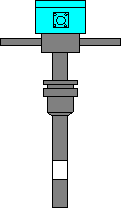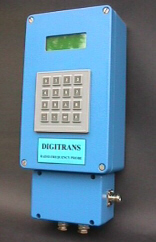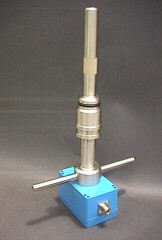
Digitrans Industrial Controls
Description of the Digital
Probe
PRINCIPLE OF OPERATION
The patented measuring method used in the Digitrans Digital RF Probe uses digital measurements only with a self compensating system to eliminate temperature effects in the measurement head. The effects of the capacitance and conductivity on the probe are measured in terms of frequency and then these frequency readings are converted to engineering units (Brix, concentration etc as required) by a digital controller.
DESCRIPTION
The complete system consists of a probe which fits into the vessel or pipe in which measurements are to be carried out and a seperate control unit. The control unit can be used to connect two RF probes. The probe body is made of 316 stainless steel.A sealed die cast aluminium box on the end of the probe houses the electronics module which is potted in epoxy for extra ruggedness. The controller, situated in another aluminium housing, has a LCD display and 16 key keypad and provides two 4-20 mA outputs for each probe.
A 4-20 mA input is provided for each probe to which temperature transmitters may be attached if temperature correction is required.
The controller and probes are connected by means of a coaxial cable which carries power to the probe and the frequency signal back from the probe.


Digital probe and controller.
APPLICATIONS
The digital probe is used wherever a linear indication of accurate brix readings is required. It may be used on high and low purity solutions but is of greatest use in high purities. The different model probes are used as follows
Model T2
Used in liquor, batch pans and refinery pansModel T3
Used in continuous pansModel T4
Used in batch pansCALIBRATION
The instrument can be pre calibrated with the general characteristic of the product if this is known or for greatest accuracy can be calibrated in situ in the process. The process liquor has to be taken through the entire brix range that is anticipated while samples are taken and calibration readings are recorded in the controller for each sample.The samples are then analysed for brix and the results of laboratory analyses are entered next to the corresponding frequency readings. The controller carries out a regression on this data after which the instrument is automatically calibrated using the coefficients produced by the regression. The two outputs may be calibrated differently for two different products or in some cases it is possible to measure two different parameters on the same product. e.g. brix and ash
DIGITRANS PROBES
Models...........................Total Length....................Wetted LengthDIGITRANS CONTROLLER - MODEL C2
Home